Drying levels
The number of separate trays on which food can be placed during drying.
The design of the trays in food dryers can vary. Typically, they consist of separate closed compartments, but another option is a common chamber with shelves (refer to the "Location of the fan (heater)" section for more information). Regardless of the specific design, the trays are positioned vertically, with multiple trays or "floors" in modern food dehydrators. The most modest option is actually
3 trays;
4 trays — also quite a small number;
5-tray dehydrators are the most popular; noticeably less common models with
6 trays or
8 trays; and in individual devices
9 or more trays can be provided (12, and sometimes 20).
Using multiple trays or "floors" in a food dehydrators ffers several advantages. It allows for increased capacity while maintaining a compact width and depth for the entire device. The more tiers there are, the smaller the area of each individual tray becomes, enabling a smaller overall width and depth of the dehydrator. This is particularly beneficial when space is limited on a table or surface, but there is ample vertical space available. Additionally, having multiple trays allows for simultaneous drying of different types of products with varying drying times. By using ce
...rtain techniques, individual compartments and shelves can be removed without having to turn off the device. However, it's important to note that increasing the number of levels in the device affects its height and cost, reduces the capacity of each individual tray, and necessitates the use of more powerful fans to ensure even heat distribution.
It's important to note that the presence of numerous trays does not necessarily indicate a powerful or spacious food dehydrator. This design can be found in compact models as well. Devices with 3-4 tiers often do not significantly differ in capacity, although there may be exceptions to this.
At the same time, there are also models whose equipment with trays significantly exceeds the number of drying levels. But our paragraph indicates how many levels (trays) can be used simultaneously when drying.Tray size
Horizontal dimensions of one dryer tray.
For round models, this paragraph usually indicates the diameter (for example, “Ø250”), for other cases — the length and width. Anyway, the information about the size allows you to estimate the total area and, accordingly, the capacity of the device. At the same time, note that a larger size affects the dimensions and weight of the structure, and also requires more heating power (ceteris paribus).
Tray height
The size of one tray of the dryer in height. In models where, instead of separate trays, a common working chamber with removable shelves is provided, the distance between two adjacent shelves is indicated.
This size primarily determines the thickness of individual pieces of vegetables, fruits, etc., which can be placed in the device. At the same time, note that the contents should not fill the tray tightly — there should be at least a couple of millimetres of space between the products and the “ceiling”. Also note that in some models, two height values can be indicated in this paragraph — for example, “15 — 25 mm”. This means that the size of the trays can be changed, adjusting them to the specifics of the situation; usually it is a choice between two standard heights (in our example — 15 mm and 25 mm).
Power consumption
Rated power consumed by the dryer during operation.
This parameter is usually selected by manufacturers depending on the volume of the dryer: the larger the device, the more power is needed to effectively heat the working chamber. At the same time, models with the same volume may differ in power consumption. In such cases, it is worth considering that a higher power reduces the heating time, but affects the price of the device.
Shutdown timer
A special device that turns off the heating after a predetermined time.
The presence of a
timer greatly simplifies the use of the device: instead of monitoring the duration of the process and manually turning off the heater, it is enough to set the desired turn-off time in the settings. In addition, this function reduces the risk of forgetting about drying products and “overexposing” them in the dryer: this can only happen if the timer was initially set for too long.
Note that the type of timer directly depends on the type of control (see above); at the same time, mechanical timers are simple and inexpensive, but they have a rather noticeable error, and electronic ones are very accurate, but they cost accordingly more.

